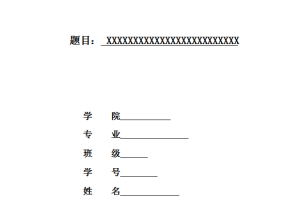摘 要
公司治理结构是借以处理公司中各种合约,协调和规范公司中各利益主体关系的一种制度安排,这种制度安排的基础是所有权结构。所有权结构决定着公司的治理结构,公司治理结构通过内外治理机制而间接影响着公司的治理绩效。由此可见我国民营上市公司治理绩效的好坏与股权结构的合理程度有很大关系。
正是基于此,本文从论述我国民营上市公司股权结构(股权集中度)与公司价值的关系入手,评述现有研究的不足,从理论上论述股权结构与公司治理的关系,说明适度的股权集中度有利于公司治理绩效的提高;然后对我国民营上市公司的股权集中度与公司价值之间的关系进行了实证分析,最后根据理论论述和实证结果,提出相关建议以提高上市公司治理绩效。
本文分为四个部分:
第一章:绪论。对研究背景、问题提出、国内外研究文献综述、研究意义、结构等作简要介绍,为论文的建立理清思路。
第二章:股权结构与公司治理的理论研究。首先介绍了股权结构与公司治理的相关概念;然后分析介绍了公司治理理论。这部分内容是本文分析和研究的基础。
第三章:提出假设并构建相应的理论模型。这是本文研究的重点之一。这部分构建了本文的假设,即假设:民营企业价值(包括市场价值和公司业绩)与其股权集中度(前五大股东持股比例)成倒U形曲线关系;然后在假设的基础上建立相应的回归模型。
第四章:实证分析。这是本文研究的又一个重点。这部分研究以中国A股民营上市公司2005年12月31日的数据,利用SPSS13.0软件,采用多元回归的方法进行分析,对本文理论模型的结论进行了实证检验,从而证实了我国民营上市公司企业价值与股权集中度成倒U形关系。
第五章:结论。这是本文的结尾部分。根据前面的理论论述和实证分析得出结论,提出提高公司价值,构建合理股权结构的结论性建议。
关键字:股权结构;股权集中度;公司治理;公司价值;公司市场价值
Abstract
The structure of corporate governance is a kind of institution that is used to cope with most of the contract, to coordinate and standard the relationship among all the sorts of stake holders; which is based on the ownership structure. The ownership structure decides the corporate governance structure, which indirectly affects the corporate governance performance by the inside and outside governance mechanism. In my opinion the governance performance is closely related to the equity structure in our nongovernmental listed companies.
This thesis sets out from the relationship between the equity structures (the equity concentration ratio) in Chinese nongovernmental listed companies, appraising the shortcoming of the studies at present, analyzes the relationship between the equity structure and corporate governance, indicates the measurable equity concentration ratio is propitious to the improvement of the corporate governance performance. Then it makes positive studies on the relationship between the equity concentration ratio and the corporate value in Chinese nongovernmental listed companies, at the following it gives some suggestions to improve our nongovernmental listed companies governance performance;
This dissertation consists four parts:
The first part raises problems and points out the significance and the thinking of the whole thesis. This part elaborates the background and the significance of these studies, summarizes foreign and domestic studies, and then put forwards the problems in the nongovernmental listed companies, this part is the beginning of this thesis.
The second part focuses on the theoretical research about the nongovernmental listed companies’ equity concentration ratio and the firm value. First of all, this part introduces the conceptions about the equity concentration ratio and the firm value. Then it analyzes the corporate governance theory. This part is the theory basis of this thesis.
The third part put forwards the hypothesis and constructs corresponding theory model, this is one of the importance in this article. This part supposes that Chinese nongovernmental listed companies’ equity concentration ratio is closely related to the company’s value, they have the relationship of the inverse “U”. Then this part constructs corresponding regression model.
The fourth part makes positive studies, which is another importance in this article. This part analyzes the data in the 31st of twelfth, 2005, by using SPSS13.0 and the regression method, then check out the theory model above, makes sure that there is an inverse “U” between the Chinese nongovernmental listed equity concentration ratio and the firm value.
The fifth part gives conclusions and suggestions on perfecting measurable equity construct and improving firm value of Chinese nongovernmental listed companies on the basis of the above study. This is the end of this article.
Keywords: Equity structure; Equity concentration ratio; corporate governance; corporate value; the market value of corporate
目 录
1.1 研究背景与研究意义·································································· 1
1.2 国内外研究现状评述·································································· 3
1.2.1 国外研究综述································································· 3
1.2.2 国内研究现状································································· 4
1.2.3 评价·············································································· 6
1.3 问题的提出············································································· 8
1.4 研究范围及研究方法·································································· 8
1.5 研究思路及结构········································································ 9
2 股权集中度与公司价值相关理论解析···················································· 11
2.1 股权结构················································································ 11
2.1.1 相关概念的内涵···························································· 11
2.1.2 股权集中度与公司价值的关系········································· 13
2.2 公司治理理论·········································································· 15
2.2.1 委托代理理论······························································· 15
2.2.2 管家理论······································································ 16
2.2.3 利益相关者理论···························································· 17
2.2.4 “内部人控制”的公司治理理论··········································· 19
3 股权集中度与公司价值关系的实证分析················································· 20
3.1 样本的选取············································································· 20
3.2 模型构建················································································ 20
3.2.1 假设的提出和模型的建立··············································· 20
3.2.2 研究变量说明······························································· 21
4 回归分析··························································································· 26
4.1 本上市公司股权集中度的统计性描述·········································· 26
4.2 公司绩效总得分(F值)的因子分析·········································· 27
4.3 股权集中度与公司绩效的回归分析与检验··································· 28
5 主要结论与政策建议··········································································· 32
5.1 主要结论················································································ 32
5.2 政策建议················································································ 33
5.3 创新与不足············································································· 33
7 参考文献··························································································· 40





